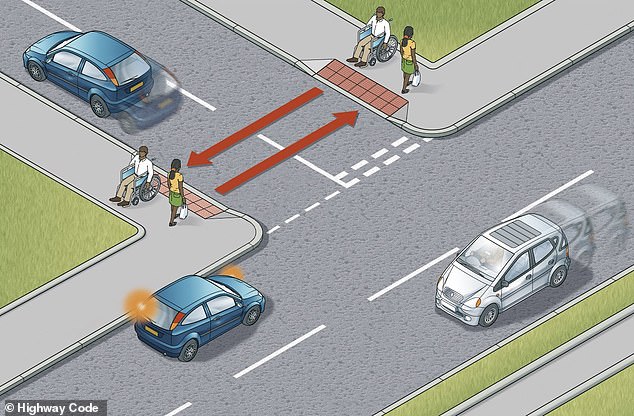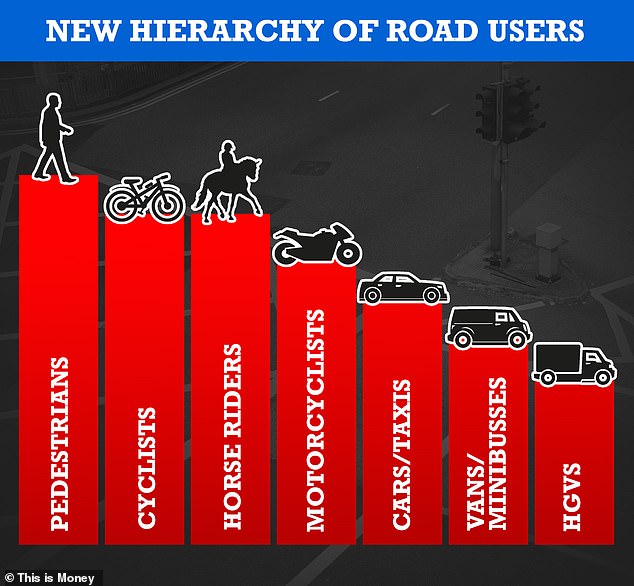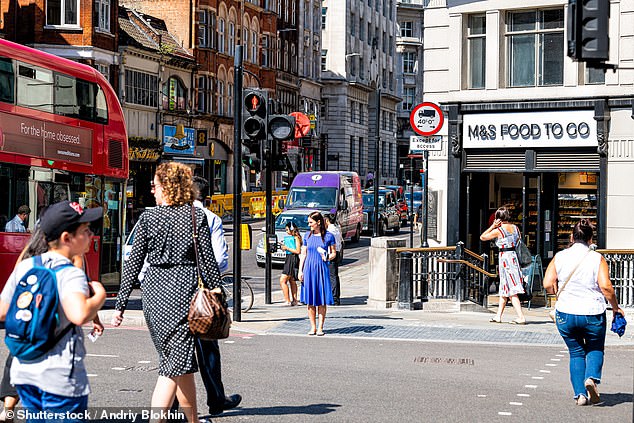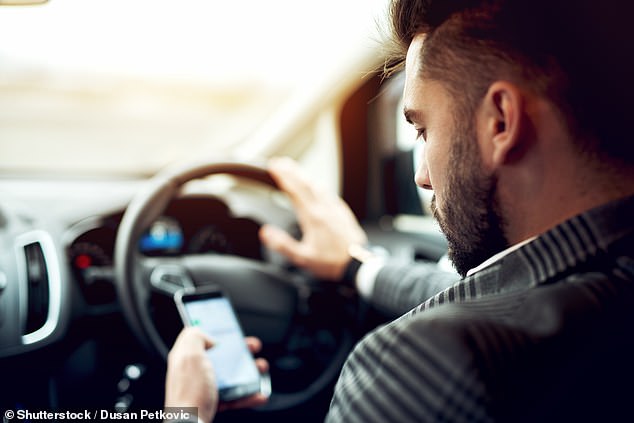Major changes to the Highway Code introduced two years ago have sparked a huge rise in fixed penalties issued to drivers, new government figures released today show.
Updates to the code in 2022 included increased priority for pedestrians and cyclists, especially at junctions, and the closing of a loophole around the use of mobile phones at the wheels.
Home Office figures published today show the number of fixed penalty notices (FPNs) issued for ‘neglect of traffic signs and directions and of pedestrian rights’ surged by a third that year, while FPNs for using a phone when driving almost doubled.
The Home Office figures have been published days after an RAC poll revealed that motorists believe the changes to the Highway Code designed to make roads safer for pedestrians has failed.

One major changes to the Highway Code in January 2022 has seen pedestrians given right of way over drivers at junctions
The Highway Code, which contains advice and rules for people using Britain’s roads, was amended by the Department for Transport (DfT) on 29 January 2022 to provide more protection for vulnerable road users, particularly pedestrians and cyclists.
A ‘hierarchy of road users’ rule was the headline-grabbing change: a pyramid-style scheme that means drivers of vehicles that can cause the greatest harm bear the most responsibility to take care of others around them.
Part of the changes linked to the hierarchy was a new rules around who has priority when a motorists is turning at a junction and a pedestrian is crossing – or waiting to cross – the road.
The new ruling states that in all instances it is the pedestrian who has the right of way over the traffic – including cyclists – and drivers should wait and allow them to get to the other side.

The hierarchy of road users is a pyramid scheme of protection to keep those who are most vulnerable safe. It means pedestrians and cyclists have far more right of way than before

A poll of drivers suggests 2022 changes to the Highway Code have done very little to boost pedestrian safety, especially as more than three quarters of motorists claim to ignore the rule about pedestrians having priority at junctions

This graphic shows how the Highway Code now gives pedestrians right of way at junctions, even if they are still waiting to cross as a car approaches
Yet very few of the 2,500 motorists surveyed by the RAC this month said they do this.
Less than a quarter (23 per cent) of respondents claimed to always give priority to pedestrians at junctions since the rule change, while a similar proportion (19 per cent) admitted they do not stop very often – and 6 per cent said they never give way to pedestrians in these scenarios.
And this has been reflected in the Home Office’s data.
It shows that FPNs issued to motorists for ‘neglect of traffic signs and directions and of pedestrian rights’ – which includes being caught ignoring no entry signs – surged from 78,900 in 2021 to 105,500 in 2022. That’s an increase of 33.8 per cent.
The AA says the rise can be partly attributed to the Highway Code’s new rules introduced around the hierarchy or road users.
But while FPNs for the offence type increased, road casualty figures suggest the new rules around pedestrian priority have done little to bolster their safety on Britain’s roads.
The Government’s road casualty statistics for 2022 showed that three in ten pedestrian fatalities occurred at junctions.
The official figures also reveal that pedestrian casualties on our roads increased in 2022 compared to the year previous.
In 2021, 361 pedestrians were killed compared to 385 the following year – a rise of 7 per cent.
Fixed penalties for using a phone almost doubled – but are tiny compared to the volume of FPNs for speeding
Just two months after the DfT added the hierarchy of road users to the Highway Code, the rule around the use of handheld devices at the wheel was updated in the handbook as part of a crackdown on motorists using their phones when driving.
The 25 March 2022 update made clear laws around the use of mobile phones after a number of high-profile cases of drivers using a loophole in the Highway Code wording that said using a handheld devices was only illegal when being used for ‘interactive communication’, such as making or receiving a call.
This rule is now applied to using almost any of a device’s features while driving, with the exception of dialling 999 in an emergency and using a smartphone to make a contactless payment only when a vehicle is stationary.

Changes to the Highway Code in March 2022 have helped to close a loophole around the use of mobile phones at the wheel. This saw FPNs issued to drivers for this offence almost double
Rule 149 now states: ‘You MUST exercise proper control of your vehicle at all times.
‘You MUST NOT use a hand-held mobile phone, or similar device, capable of interactive communication (such as a tablet) for any purpose when driving or when supervising a learner driver.
‘This ban covers all use of a hand-held interactive communication device and it applies even when the interactive communication capability is turned off or unavailable.
‘You MUST NOT pick up the phone or similar device while driving to dial a number and then put it in the cradle for the duration of the conversation.
‘You MUST NOT pick up and use your hand-held phone or similar device while stationary in traffic.’
The offence carries a minimum fine of £200 that can increase up to £1,000 – and six penalty points on the driver’s license. First-time offenders can sometimes be offered driver awareness course instead of the penalty points.
And Home Office figures show the number of FPNs for this offence type doubled year-on-year.
Some 37,900 FPNs were issued to drivers caught on their phones in 2022, up from 19,600 the year before. That’s an increase of 93 per cent.
Yet these numbers pale in comparison to the number of penalty notices issued to drivers for speeding.
The Home Office figures released on Wednesday show that the number of motorists caught speeding reached a record highs of 2.52 million. This is up from 2.37 million in 2021 – a year-on-year rise of 6 per cent.
The AA said the growth in FPNs issued for these offences is not down to increased police enforcement – especially with fewer officers on the road today – but the greater use of cameras across Britain.
And it added that the rise in use of dashcams in cars – as well as cameras used by cyclists, motorcyclists and horse riders – are helping capture bad driving through Operation Snap.
Police forces across the UK are now receiving more video footage and evidence of dangerous and poor road behaviours, meaning that the chances of being caught has grown significantly through citizen owned cameras.
Jack Cousens, head of roads policy for The AA, said almost 3 million drivers were caught and prosecuted for how they acted on the roads in 2022 and welcomed the tightening of the law for using a handheld mobile phone behind the wheel.
‘The AA led the campaign to highlight the dangers of picking up the phone while driving, now we need drivers to hang up their handset rather than fiddle with the phone,’ Cousens said.
‘With the rise of dashcams and riders wearing cameras, drivers behaving badly should beware that someone is always watching. Police forces are utilising the footage to hold drivers to account and using the film as evidence to prosecute offenders.
‘Police owned and private cameras are a useful tool in catching bad driving in the act, but we do not want to see an overreliance on technology.
‘The best way to deter illegal driving behaviours is to increase the number of traffic officers and visible presence on our roads.’
Some links in this article may be affiliate links. If you click on them we may earn a small commission. That helps us fund This Is Money, and keep it free to use. We do not write articles to promote products. We do not allow any commercial relationship to affect our editorial independence.











